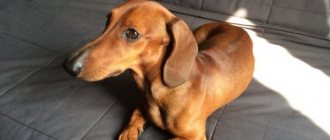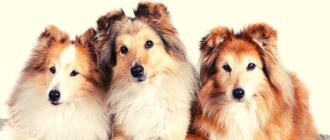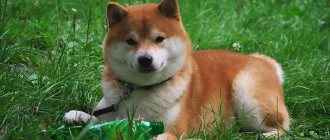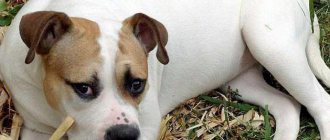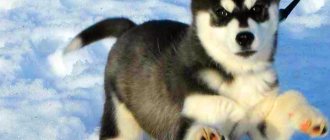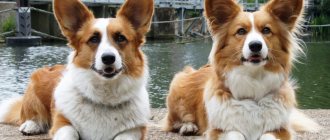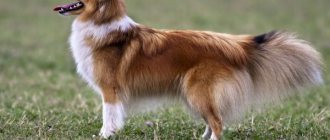Breed traits
Breed traits (on a 5-point scale)
| Alaskan Malamute | |||
| Activity | in the house | 2.4 | |
| on the street | 4 | ||
| Obedience | training | 2.8 | |
| strangers | 3 | ||
| Domination | in family | 2.2 | |
| over dogs | 3.8 | ||
| Defending your territory | from people | 1.8 | |
| from dogs | 4.2 | ||
| Sociability | in family | 4.8 | |
| with strangers | 3.6 | ||
| with dogs | 2 | ||
| Concentration | in family | 1 | |
| in front of strangers | 1.4 | ||
| with dogs | 2.2 | ||
| Aggressiveness | in family | 1 | |
| to strangers | 1.4 | ||
| to the dogs | 3.2 | ||
| to cats | 3.6 | ||
| Family behavior | calmness | 3.6 | |
| demand for affection | 4.6 | ||
| excitability | 3.6 | ||
| playfulness | 3.2 | ||
| excessive barking | 1.8 | ||
| behavioral breakdowns | 2.4 | ||
| Tolerance for children | up to 4 years | 3.4 | |
| over 4 years old | 3.6 | ||
| Institutional use | watchman | 3 | |
| bodyguard | 1.4 | ||
This breed is often compared to the following dog breeds: Samoyed, Akita Inu, German Shepherd, Siberian Husky, Labrador Retriever.
Photos of Malamute dogs:
Malamute muzzle
Rest on benches
Alaskan Malamute
General characteristics of the breed
The Alaskan Malamute is descended from a wolf. This is the oldest aboriginal breed, which has long lived next to humans. This large dog, even a giant, is very kind and affectionate in character. Due to his large height and powerful physique, he seems dangerous, but in fact he is not at all aggressive. Outwardly, Malamutes are similar to huskies, but they have a more independent and independent character.
This is an ideal working dog, very hardy and strong. But these dogs love people very much and trust them, so they are not suitable for the role of a guard. They are kind and friendly, do not show aggression, and are not capable of biting. This dog will take care of and accompany his beloved owner everywhere. He will become a devoted friend, a faithful companion, and a child's playmate.
| Options | Characteristic |
| breed name | Alaskan Malamute |
| country of origin | USA |
| group of breeds under the ICF classification | Spitz and primitive type breeds, northern sled dog section |
| year of breed registration | 1935, standard adopted in 1963 |
| height | males: 63-64 cm, females: 58-59 cm |
| weight | males: 36-43 kg, females: 32-38 kg |
| life expectancy | 13-16 years old |
| working qualities | hunting, sledding, companions |
| attitude towards a person | friendly, love all people, but tend to dominate |
| need for communication | their purpose is to serve people; they cannot stand loneliness |
| aggressiveness | not aggressive |
| training | difficult, you need to gain authority |
| health | strong, unpretentious, live long |
| need for care | difficult to care for, they shed a lot |
| activity | very active, playful, efficient, love to dig |
| noise | do not bark, can howl, make sounds similar to meowing |
pros
The Alaskan Malamute is an ideal pet for athletes and outdoor enthusiasts. He can become a faithful companion, playmate and travel assistant. Representatives of this breed have many advantages:
- very hardy, efficient, can withstand high physical loads;
- friendly, sociable, affectionate, very devoted to the owner;
- have an attractive, luxurious appearance;
- get along well with children, will never bite them, can become a nanny;
- not aggressive, kind, love all people;
- get along with dogs, cats and other pets;
- have good health, can withstand low temperatures, can be kept outdoors;
- smart, quick-witted, easy to train with the right approach;
- playful, cheerful.
Cons of the breed
The Alaskan Malamute is a good-natured and devoted companion, but quite difficult to keep and train. Due to his high intelligence and independent nature, this dog is difficult to train. It is not suitable for inexperienced owners, weak ones who cannot become a leader. People who are rarely at home and cannot pay much attention to their pet should not get one.
These dogs have several other disadvantages:
- due to its size it is difficult to keep in a city apartment;
- cannot tolerate hot weather;
- out of boredom and loneliness they can cause great damage to household property and howl loudly;
- require a lot of attention, can be intrusive, and are not suitable for keeping on a chain;
- Sheds a lot and is difficult to care for;
- stubborn, strive to dominate, can make independent decisions;
- high physical activity is required, intensive training is required;
- they love to dig, they are able to dig up the entire garden, dig under the fence and even ruin the floor in the house;
- They do not have watchdog and protective qualities, as they love all people.
In the video you can learn about the pros and cons of Malamutes:
Video: Pros and cons of the breed
Video: Alaskan Malamute pros and cons of the breed
Interesting facts about Alaskan Malamute dogs
Malamutes have been living next to humans for a long time. Since the time the breed became known in the world, it has not lost popularity. A lot of interesting facts about these dogs have accumulated:
- they are so strong and durable that they can pull a load of up to 1.5 tons;
- these dogs became a symbol of Alaska in 2010;
- shedding continues throughout the year, they shed their fur especially heavily in spring and autumn;
- representatives of this breed hardly bark, they communicate by howling, like wolves;
- They cannot stand loneliness at all, and with a lack of attention they become uncontrollable;
- suitable for harness racing, skijoring, canne-cross, Frisbee;
- thanks to endurance, love for people and the ability to make independent decisions, they can become good rescuers;
- Malamutes are big fans of digging, which can cause a lot of problems when kept on the property;
- these dogs are so similar to wolves that they are often played in films;
- In America, a dog of this breed was used to train artificial intelligence to think like a dog.
Interesting photos of Alaskan Malamutes:
Alaskan Malamute mouth
Walking with a child
Alaskan Malamutes in harness
Huge Malamute
The Malamute is a large, powerful sled dog that can weigh about 50 kg; the height at the withers of some dogs reaches 76 cm, although the most preferred height is just over 60 cm. The majestic appearance of this impressive, wolf-like, very beautiful dog leaves no one indifferent. (Several Malamutes already live in Russia; most likely, these charming dogs will find many fans among us). Story.
Malamutes are dogs of one of the Eskimo tribes known as the Malmute. The Malmute tribe inhabited the upper Anvik River in Alaska. At the time, these large dogs were used to transport cargo in extreme Arctic conditions. Their stamina allowed them to carry heavy loads over long distances, and the Gold Rush of 1896 created a great demand for these dogs.
Today, there are two different types of Alaskan Malamutes. One line called - M'Lut and the other - Kotzebue. One difference between these two lines is the size of the dogs. M'Loot Malamutes are larger than Kotzebues. In addition, the true Kotzebue Malamute is only wolf in color, but in the M'Lut line there is a variety of colors - wolf, black and white, sable and white, blue and white. Kotzebue dogs are less aggressive than M'Loot and more active. The Kotzebue Line was run by Arthur Walden and the couple Milton and Eva Seely. It was Milton and Eva who registered the Kotzebue line dogs with the AKC in 1935. Paul Walker bred the M'Loot line dogs. Paul didn't register his dogs, but he sold them to people who eventually did. There is still a debate among breeders about which Malamute is called “correct,” but, fortunately, representatives of both lines have not yet lost their working qualities.
Character.
The Malamute is a very friendly dog with a “plush” appearance: it loves to be the center of attention, which is why Malamutes are often called “big bears.” These kind “wolves” are always ready to respond to an invitation to play, and they themselves will amuse the owner with their funny pranks. Dogs of this breed are oriented towards life in a “pack”, so they feel best in a family environment than left to their own devices somewhere in the yard. The Malamute cannot be called a “one man’s dog.” They are extremely intelligent, but can be very stubborn if they get bored with their activities. The dog can become stubborn when repeating the same command repeatedly. Malamutes easily learn new skills and will happily obey their owner's command once or twice, but they will soon become bored with the learning process (this character trait is common to many northern breeds). The Alaskan Malamute cannot be recommended as a first dog to a novice owner, because when raising a puppy of this breed it is easy to make mistakes, which will then be extremely difficult to correct. Unfortunately, Malamugs are often “rejected” dogs; a person falls in love with a cute puppy, and later cannot cope with a large and stubborn dog.
The strong character of Malamutes “obliges” them to dominate other dogs, so they can be aggressive towards their relatives. The owner needs to introduce the puppy into the “dog society” as early as possible, stopping any attempts by the pet to start a “showdown.”
Malamutes are not aggressive with people, so training them for protective service is not recommended - why “break” the character of these good-natured dogs? Their friendliness towards absolutely everyone makes them poor watchdogs, however, with their impressive appearance they can scare away the uninitiated “intruder”. But it may also happen that a dog licks a thief who has broken into the house, as if he were a close family friend, and there is nothing you can do about it - a Malamute is a Malamute...
One feature of representatives of this breed deserves special attention - the ability of Malamutes to “talk”. They bark very little, but they carry on a “conversation” with the owner, emitting a dull “ooo-woo-aw.” Remember Chewbacca in the movie “Star Wars”. True, the owners of Malamutes claim that it is enough to ask, and the dogs immediately stop their “grumbling”.
Wool and its care.
Malamute is a dog with a well-developed undercoat. Malamutes shed twice a year. At this time, they need to be combed out more often. In very warm climates, the Malamute may lose its fur little by little throughout the year. These are very clean (like cats) and almost odorless dogs, so they should be washed rarely (1-2 times a year). Malamutes do not need to be trimmed; the only care is regular brushing and trimming of the nails on their paws.
Health.
Diseases that occur in dogs of this breed: gastric volvulus; eczema; Possible weakened pigmentation of the nose (the so-called “snow nose”, pink or light gray); genetically determined eye diseases (retinal atrophy and hemeralopia - “day blindness”); hip dysplasia; dwarfism (found in the M'Lut line; a testing system has been developed).
Nutrition.
The impressive size of the Malamute can be misleading; it begins to seem that such a dog is difficult to feed, but this is not so. They eat much less than most other breeds of the same size and weight. Malamutes have a strong food motivation (this can be used during training), but you should not allow them to eat as much as they want, because the dog will not stop until it eats everything, and this can lead to stomach volvulus. Their passion for food is so strong that the dog will not stop even before stealing (you should not leave food on the table).
Content.
The highest happiness for a Malamute is to take part in all the affairs of his “pack” (family). The dog feels best when it is able to leave the house on its own, for example, through a special “doggy door”. It’s good when there is a large piece of land where the dog can stretch, but a high fence is required, because like all northern breeds, Malamutes love walks alone. (Don't let your dog run away and wander!). Malamutes are notorious for being excellent diggers. It is advisable to place a box of sand somewhere in the corner of the yard and train the dog to dig there, but it is impossible to train the dog not to dig at all. The desire to dig is an ancient instinct of dogs of this breed, for in the past, tearing the ground to the very permafrost, they caught rodents (their food). Digging up the area over and over again, these dogs enjoy the process of work itself. You can immediately tell that a malamute lives in the yard, seeing that the area is more reminiscent of a lunar landscape with picturesque craters...
In addition to the desire to tear up the ground “inherent in the genes,” Malamutes have strong hunting instincts. Forgetting about everything in the world, the dog will chase everything that runs, squeaks or squeals. It is difficult to keep a Malamute from chasing a cat or bird, so you should not leave the dog unattended, alone with small pets.
Malamute is a northern breed; these dogs feel great outside even in severe frost. It is ideal to keep Malamutes not in an apartment, but outside, in an insulated booth. Dogs love to climb onto the roof of the kennel and look around their property with a majestic look.
Education.
The Malamute is a dominant breed. It is important to prove to the dog as early as possible that the place of the leader of the “pack” has already been taken and it is useless to claim it. Then the dog will respect the owner, and it will be much easier to teach him obedience. The owner must be creative when training a Malamute: these smart dogs are well versed in the situation and can follow commands on the playground and not obey at all at home. The main thing is to stay busy, constantly proving to the stubborn pet that the leader is the owner, and not the malamute.
It is important to remember that the Alaskan Malamute is a working breed. He definitely needs work, whether it be engaged in sledding sports (this is welcome!), skijoring, frequent walks and bike rides, or games. On hikes, this wonderful companion will happily carry a backpack with food and water on his back.
In long-distance races, they are inferior to Siberian huskies, but strong, hardy malamutes are faithful assistants to people on research expeditions to the North Pole or Antarctica, as well as frequent participants in weight-pulling competitions. Don't forget that in the past these dogs were used primarily as draft animals - the Malamute can move more than a thousand pounds (about 400 kg). Thanks to their cheerful character and charming appearance, “mels” (as they are called for short in America) take part in the “animal-assisted therapy” program - they visit sick people in hospitals.
History of the origin of the Alaskan Malamute breed
Alaskan dogs are representatives of the oldest indigenous breeds in North America. Excavations have proven that they lived next to humans 3 thousand years ago. It is believed that modern northern giants are descendants of domesticated wolves. And genetic studies conducted at the beginning of the 21st century proved that they have hardly changed since ancient times. Their relationship with Siberian huskies was also revealed. This proves that these dogs came to the American continent along with man from East Asia through the Bering Strait.
The Alaskan Malamute got its name from the Eskimo Malemiut tribe. It was previously the most numerous and lived in the coastal areas of Alaska. These dogs were irreplaceable helpers for humans. They carried loads, helped hunt, protected from predators, and warmed children with their bodies.
They were not specially bred, but the strongest survived in harsh climatic conditions. The dogs had to withstand cold and hunger, and carry heavy loads. Therefore, they were giants with a powerful physique, thick hair, hardy and strong. For the Malemiuts, they became family members and often saved their owners. The dogs were peaceful, hardworking, smart.
Old photographs are interesting, which show that the appearance of the breed has not changed much:
Old photo of Malamute
The appearance has not changed since then
Historical photo
They became known to other nations at the end of the 19th century. This was the time of the gold rush, when many Europeans came to America. They brought their sled dogs with them, but Malamutes were especially adapted to the harsh conditions. The breed became very popular, they were bought at a high price.
But people sought to get an even more durable and fast dog. Therefore, they began to cross Malamutes with other dogs. Because of this, the breed was in danger of extinction. Only through the efforts of enthusiasts were purebred representatives preserved. At the beginning of the 20th century, there were two breeding lines: Kotzebue and M'Loot.
The first variety was bred in New Hampshire from individuals brought from the Norton area. Kotzebues were less aggressive and smaller. They have retained their original wolf coloring. M'Loot are larger, stronger dogs. They had different colors. From these two lines the modern Malamutes originated. Although now it is impossible to determine their variety, since they are mixed.
Officially as a breed, Alaskan Malamutes were recognized in 1935. But during the Second World War they almost disappeared again. Due to their intelligence and working qualities, Malamutes were often used for military purposes in the North. And by the end of the 40s, only a few dozen individuals remained. But gradually the breed's numbers were restored.
By 1963, a single standard was approved. These dogs have retained the appearance and habits of their ancient ancestors. Now Malamutes are one of the most popular breeds and the official symbol of Alaska. They appeared in Russia only in the mid-90s. There are several regional varieties: Siberian, Altai, Yakut, Valdai. Outwardly, it is almost impossible to distinguish them from the original representatives of the breed. The difference is noticeable in character, habits and working qualities. But the purebred Alaskan Malamute is also popular in Russia.
The pictures show the working qualities of these dogs:
In harness
Sled in the snow
Participate in races
Health and Diseases of the Alaskan Malamute
Alaskan Malamutes are quite hardy dogs, adapted to life in extreme climatic conditions, but diseases do not bypass them. They are prone to neurological disorders affecting the peripheral nervous system - polyneuropathy.
Representatives of this breed also suffer from diseases such as hip dysplasia, anal adenocarcinoma, diabetes, and hemophilia. They also suffer from skin diseases: atopic dermatitis and demodicosis (the latter is caused by the Demodex mite).
Eye pathologies are also common in Malamutes, such as progressive retinal atrophy, cataracts, day blindness (hemeralogy), and glaucoma. They also suffer from bloating and a thyroid disorder called hypothyroidism. Oddly enough, these northern giants sometimes exhibit dwarfism.
Alaskan Malamutes, unlike some other breeds, are distinguished by their enviable longevity. They live on average 13-16 years.
Description of the appearance of Malamute dogs
This is a large sized dog. According to the standard, the height of Malamutes reaches 64 cm. Due to their powerful build and fluffy fur, they appear even larger. The average weight of a Malamute is 38-40 kg, but can reach up to 50 kg. The skeleton is large, the muscles are developed, so the dog looks impressive and menacing.
The main features of appearance are a strong build, muscular paws, a large head, a wide chest and thick fur. From the outside, Malamutes are very similar to wolves. This is a beautiful, harmoniously built dog.
The pictures show what Malamutes look like:
Appearance
Appearance
Head
The Malamute's head is large, wide, and proportional in size to the body. Between the ears the skull is rounded, gradually tapering towards the eyes. The stop is clearly defined, the muzzle is large, not narrow. The jaws are powerful and have a scissor bite. The lips are close-fitting and black. The eyes are almond-shaped and medium in size. Set wide, slightly askew. Their color is dark or amber. The look is good-natured, smart. Blue eyes are not allowed by the standard.
The nose is large and black. In winter, pigmentation may be weaker. The ears are triangular in shape, rounded at the ends, and medium in size. Planted far from the eyes. The ears are erect, very mobile, their position depends on the dog’s mood. When the Malamute pulls the load, it lays them back.
Body type
The physique is harmonious and powerful. Wide bones and strong muscles make this dog hardy and efficient. The body is almost square in format, compact, but the length is slightly greater than the height at the withers.
The neck is muscular and wide. The back is straight, the lower back is muscular. The stomach is not tucked. The tail is covered with thick hair. The dog holds it raised above his back, but does not twist it into a ring.
Limbs
The limbs of this dog are muscular, straight, parallel. The hock joints are weakly defined and located low. The movements are powerful, smooth and confident. The paws are adapted for walking in deep snow. The pads are well developed, the claws are long and retractable, like those of a cat. The fingers are tightly closed, there is a lot of wool between them. Therefore, the dog does not fall into the snow and does not slide on the ice.
Coat and colors
The Malamute has a double coat. The top layer of wool is hard. It is longer on the neck, shoulders, hips, back and tail. The undercoat is thick, dense and soft. This cover protects the dog from frost and moisture. In summer, the coat becomes shorter and thinner.
The most common color is wolf. Sometimes sable is found. Nowadays pure white Malamutes are also common. But usually several colors are combined. White on the belly, paws, and in the form of a mask on the face. Spots are allowed only on the head; the coloring on the body is uniform.
Photos of Malamutes of different colors:
Sable color
Wolf color
Sable color
Varieties
Now two lines of the breed are no longer distinguished: Kotzebue and M'Loot. Although there are slight differences between them. Kotzebues are smaller and good-natured. They are more suitable as a companion and pet. M'Loot - large, hardy, can be aggressive. They are more often used as workers and guards.
When the breed became popular throughout the world, breeding work began in different regions. Malamutes are not crossed with other breeds, but individuals with the desired qualities are left for breeding. This is how several regional varieties appeared that look the same, but there are slight differences:
- American;
- English;
- Canadian;
- Siberian;
- Tibetan;
- Alpine;
- Japanese;
- Chinese;
- Yakut.
Photos of breed varieties:
Differences from similar breeds
Most often, Malamutes are confused with Huskies; these are also northern sled dogs; they have common roots. But they belong to different breeds, differ not only in appearance, but also in habits. The main difference: the Malamute is larger, more durable, and can carry heavy objects. He has more weight, wider bones, and thicker fur.
Huskies are faster, but not as durable. They have a graceful build, a narrower muzzle, and ears set close together. Sometimes they are distinguished by their eyes: in huskies they can be blue, which is not allowed in malamutes.
Related breeds also include the Alaskan Klee Kai, Czechoslovakian Wolfdog, Northern Inuit, Saarloos Wolfdog, and Utanagan. Malamutes are sometimes called huskies, but this is incorrect. These breeds are very different from each other. Laikas are smaller hunting dogs. They cannot be used for transporting goods. The husky has long legs, a narrow elongated muzzle, and a tail curled into a donut.
The pictures show the differences between similar breeds:
Difference between Husky and Alaskan Malamute
Malamute and husky
Malamute on the left, husky on the right
Yakut Laika
How to choose a puppy
To avoid all sorts of risks, do not buy a puppy from your own hands, but contact registered nurseries or private breeders. The Alaskan Malamute must have documents from such official organizations as the Russian Cynological Federation (RKF) and the Union of Cynological Organizations of Russia (SCOR). You should not trust the so-called club documents, since there is a high probability that you will find yourself the owner of a dog that is not purebred or has physical and psychological defects.
Malamute puppy with mom
It is recommended to buy a puppy between the ages of 1 and 4 months. Month-old puppies are purchased by those who believe that a long stay in a pack can develop various bad habits. Accordingly, being with the owner almost from infancy, he will quickly become attached to the person. In older puppies, exterior inclinations are more accurately determined, so future owners, for whom this indicator is important, are patient and wait for the kids to grow up.
Regardless of age, Alaskan Malamute puppies should be active, curious, and have a good appetite. Characteristic features of healthy babies: dark eyes, lively eyes, straight and thick paws, small belly, thick tail. The color of the puppy must match the color of the adult dog. His fur is thick and fluffy from infancy. Puppies with great show potential, as a rule, have not only a magnificent appearance, but also self-confident, sometimes daring behavior.
A simple test can help the future owner in choosing a puppy. They put a light collar and leash on him and slowly walk away. If, after a little persuasion, the baby follows the person without crawling, whining or falling, then he will certainly grow into an excellent, balanced dog with leadership abilities.
Character of Malamutes
Alaskan Malamutes perceive everyone around them as their pack. They need to be constantly surrounded by people. They are friendly with everyone, affectionate and welcoming. They greet guests with joy and try to please them. These are not monogamous people; they easily get used to a new owner. But they constantly need attention.
The Malamute is a dog that remains a puppy until it is 3 years old. She is active, cheerful and playful. Irrepressible energy requires an outlet, so the dog never sits still and constantly demands attention. But even as an adult, he does not tolerate a sedentary lifestyle. He needs long walks, jogging, and intense exercise.
Malamutes get along well with children and can become a caring nanny and playmate. But it is not recommended to leave him alone with children. The dog will not deliberately harm the child, but since he strives to dominate and is quite large in size, he may accidentally injure him.
For the same reason, it is undesirable to keep him in the same house with small dogs, cats, and even more so rodents and birds. Malamutes have a desire to be superior to others and to command. And he can hunt small animals. Only with proper upbringing and early socialization can this dog get along with other pets.
Malamutes are not suitable for the role of guard and watchman. These are good-natured dogs, they do not bite. Moreover, they do not know how to bark, but only howl.
The photo shows the behavioral features of adult Malamutes:
With baby
With a girl
In the forest
Don't be sad…
Education and training
Malamutes are strong and independent, so it is very important to pay a lot of attention to their proper upbringing. These are smart, quick-witted dogs, they have a good memory and the ability to make decisions independently. It is very difficult to train them. To do this, you need to immediately gain authority, show firmness and perseverance. This dog will constantly strive to dominate and test all family members.
You need to raise a puppy from an early age. In order for him to immediately feel who is boss in the house, you need to follow several rules:
- the people eat first, and then the dog;
- the dog comes through the door and goes up the stairs after the man;
- should not be allowed to sleep on the bed;
- You need to pet the dog while eating;
- do not feed from the table;
- A dog should not win games or take away toys from a person.
You can independently teach your puppy to respond to a nickname, to be calm towards cars, sharp sounds, and other animals. From an early age you need to learn the basic commands: “place”, “to me”, “no”, “fu”, “near”, “sit”, “stand”.
Classes should be carried out in a playful way; Malamutes quickly lose interest in monotonous training. You cannot shout, show aggression or hit this dog. It is important to find a common language with your pet and reward it more often for success. From 4 months, it is advisable to visit the dog playground and complete a general training course.
An interesting video about the character and upbringing of these dogs:
Video: Training
Features of the Alaskan Malamute
Psst, do I look like a wolf?
The Alaskan Malamute is a large, beautiful and strong dog that looks like a wolf. The spectacular appearance, which invariably attracts attention, is complemented by irrepressible energy, which only experienced lovers of this breed, who have a keen sense of the psychology of their pets, can cope with. These northern giants treat people kindly, but strive to dominate them. In everyday life, this character trait is not considered positive, but in extreme situations it is a big plus. There are cases when, thanks to the ability to make independent decisions, a dog saved the life of its owners.
For Russia, this breed has long been exotic and represented in small numbers. However, recently in our country she has been gaining more and more fans. Many, however, are subsequently disappointed in their dog. But this is not the fault of the malamute: such a dog does not need to be acquired spontaneously, but first you should collect all the information about the characteristics of character, behavior and living conditions. The choice in favor of this breed should not only be conscious, but also carefully weighed.
Keeping adult Malamute dogs
An Alaskan Malamute will not make a cute pet. He does not tolerate loneliness or closed spaces. At home, these dogs amuse themselves by running around rooms, gnawing and destroying everything. They also cannot be kept on a chain; a dog deprived of its freedom can become aggressive and uncontrollable.
Therefore, before purchasing a puppy of this breed, you need to consider whether there are conditions for keeping it. A spacious enclosure with a warm booth is best suited for this. It is advisable to place a deep box of sand there for the dog to dig. Malamutes are often called “diggers”; you can recognize the yard in which this dog lives by its deep holes.
Features of care
It is difficult to care for the fur. It is thick, dense, and needs to be combed several times a week. During shedding - twice a day, otherwise the whole house will be covered with hair, and tangles will appear on the dog's body. It is better to comb out with a brush with stiff bristles; you may also need a slicker brush.
Regular care of your pet's eyes and ears, brushing of teeth and trimming of nails is also required. It is not recommended to bathe Malamutes often; 3-4 times a year is enough. They are clean and lick themselves. Show dogs, especially those with white fur, are bathed more often. In summer, you can give them water treatments in open reservoirs.
Health
These dogs have good health, they are hardy and unpretentious. They are long-lived, many representatives of the breed live up to 15-16 years. They can withstand low temperatures, heavy physical activity and even fasting. But they are also susceptible to some diseases:
- polyneuropathy;
- neurological disorders;
- diabetes;
- hip dysplasia;
- cataract, glaucoma.
It is also necessary to regularly receive all necessary vaccinations to protect your pet from infections. And because of the thick, long hair, it is important to treat it from parasites in a timely manner.
Nutrition
Malamutes are unpretentious eaters and are very gluttonous. They will eat even if they are not hungry. Therefore, it is important to develop a clear feeding regimen and monitor portion size. An adult dog should eat 1-2 times a day, at the same time. You cannot give a large portion at a time; these dogs are prone to volvulus.
You can feed them natural food or dry food of at least premium class. The main diet consists of porridge cooked in broth. They add meat, offal, and vegetables. You should not give bones, sausages, smoked meats, fatty and fried foods, and sweets. Unsalted crackers are suitable as a treat. You can choose any dry food designed for large dogs.
ROSY
September 4, 2022 SATURDAY EXCURSION DAY IN ROSY


